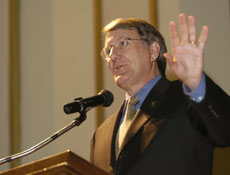X Prize director speaks at Foellinger
December 1, 2004
Just weeks after the world’s first private spacecraft re-entered Earth’s atmosphere, one of the main catalysts for the record-setting event spoke at Foellinger Auditorium on Tuesday night.
Gregg Maryniak, executive director of the Ansari X Prize Foundation, spoke about the future of space travel to an enthusiastic audience. Doug King, president of the St. Louis Science Center, also spoke.
The X Prize was a contest that challenged private groups to build and fly a craft capable of holding three people into space twice in two weeks. In October, a group sponsored by Microsoft executive Paul Allen won the $10 million prize when their craft, SpaceShipOne, made the two flights, traveling more than 330,000 feet in the air each time. Maryniak showed footage of the winning flight, which lasted only for a few minutes.
Maryniak and King said the flight of SpaceShipOne could mark the beginning of a golden age for space flight.
“It’s about time for a huge breakthrough,” King said. “Twenty-five or 30 years from now, you’ll all be going out to the spaceport to fly to London in 45 minutes, and going to take a vacation on the moon. Remember, you were here tonight looking at that funny little first commercial flight into space.”
Get The Daily Illini in your inbox!
The main problem, Maryniak said, is changing people’s perceptions of space travel.
Because space flight has traditionally been attempted only by government agencies with multibillion-dollar budgets, most people don’t realize the private sector can do the job more efficiently and cheaper, he said.
Maryniak compared the sluggish advance of space flight during the past 40 years to the rapid development of the airplane in the early 20th century. Just 44 years after the airplane was invented, Chuck Yeager broke the sound barrier in a sleek experimental jet, he said.
A big reason aviation took off is because of private prizes that enticed inventors and pilots to take risks. Charles Lindbergh, for example, flew solo across the Atlantic Ocean in 1927 in order to win a $25,000 prize offered by a New York hotelier, Maryniak said.
With private prizes, “You don’t tell people, ‘build this ship;’ you tell people, ‘do this task,'” he said.
Privatizing space flight, Maryniak said, will dramatically reduce the price of sending humans and equipment into space. Currently, it costs about $10,000 to send one pound of material into space – a cost too high for space tourism and space industrialization to be viable, he said.
However, thanks to the X Prize and other commercial space research, sending tourists into space is not a far-off dream. Sir Richard Branson, owner of Virgin Group, has purchased five returnable space vehicles and plans to start tourist flights within three years, Maryniak said. A ride in one of the vehicles, which can seat five people, will cost about $200,000. There is already a waiting list of about 10,000 people, Maryniak said.
Maryniak said studies have shown that space tourism companies can maximize their profits by charging $15,000 per ticket – the cost of a small car.
“I’d trade that car for a ride in space, and I think you might too,” he said. “This means we get to go (to space) and our children get to live there and our species gets to thrive.”
King said commercial space travel could also lead to industrial projects such as massive solar panels in space that could provide Earth with clean, abundant energy.
“When they do this activity (space tourism), they’ll … kick open the door using space flight for kind of big things – not just so rich white guys can fly into space, but so humanity can access the bounty of material resources that we are surrounded by now,” Maryniak said.
Maryniak noted that Paul Allen’s $25 million grant to build SpaceShipOne is a third of what a company pays to sponsor a NASCAR team.
Tuesday’s event was sponsored by the University’s Illinois Space Society (ISS), a Registered Student Organization. When SpaceShipOne made its record-setting flight, the club sent 34 of its members to the Mojave Desert to witness the event.
Kirk Kittell, a graduate student in engineering, said Tuesday is the first annual X Day at the University. The ISS hopes to bring speakers each year to discuss space travel, he said.
Audience members said they enjoyed the presentation.
“It was cool to just see a guy who knows about the X Prize firsthand narrate the (SpaceShipOne) space flight in person,” said David Grunschel, junior in engineering.
“I thought it was cool,” said Lynn Greetin, junior in engineering. “I hadn’t actually seen the flight before.”
When asked if she would want to go into space, Greetin said, “Maybe if it was cheaper. I think it’d be cool.”







